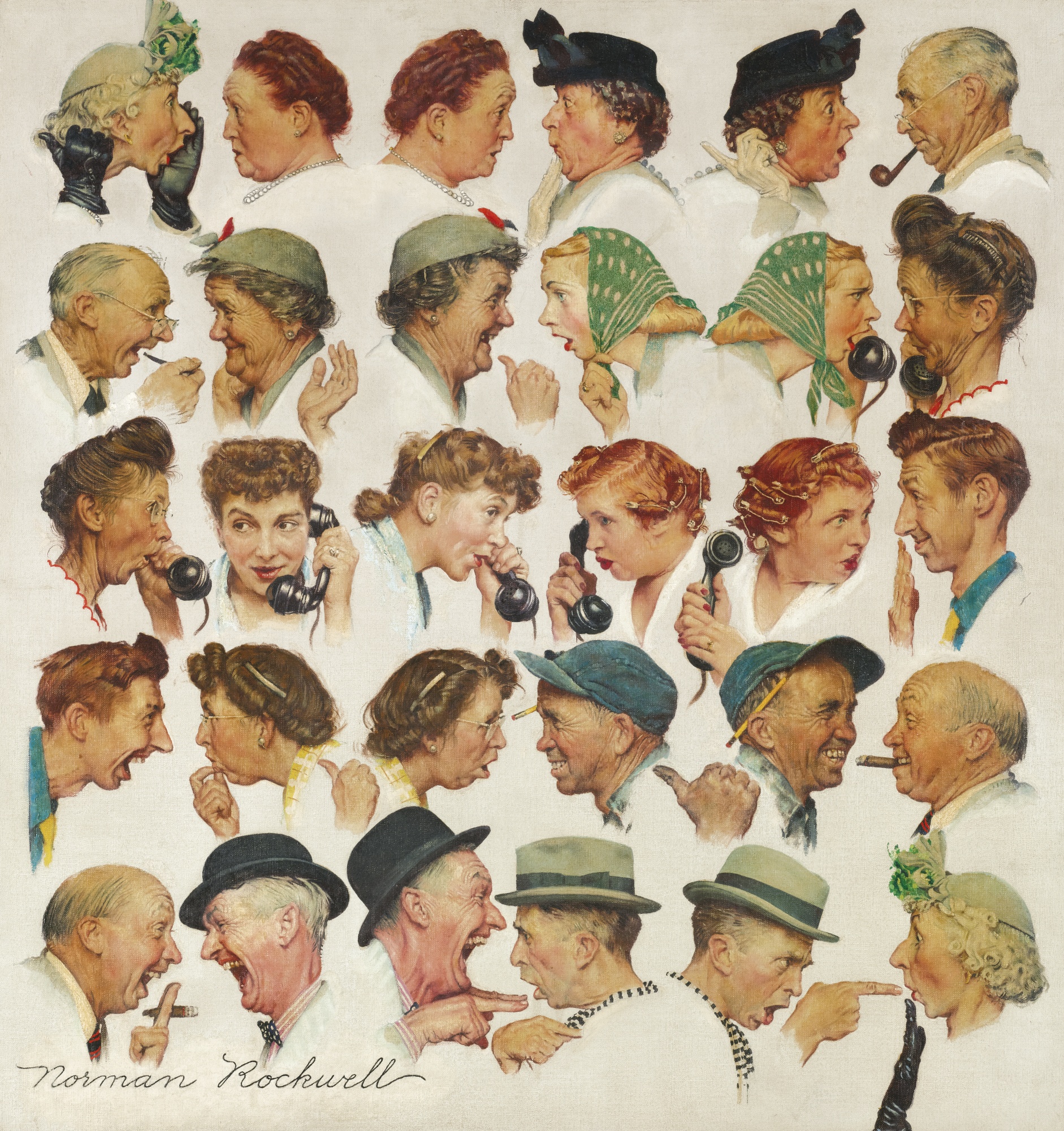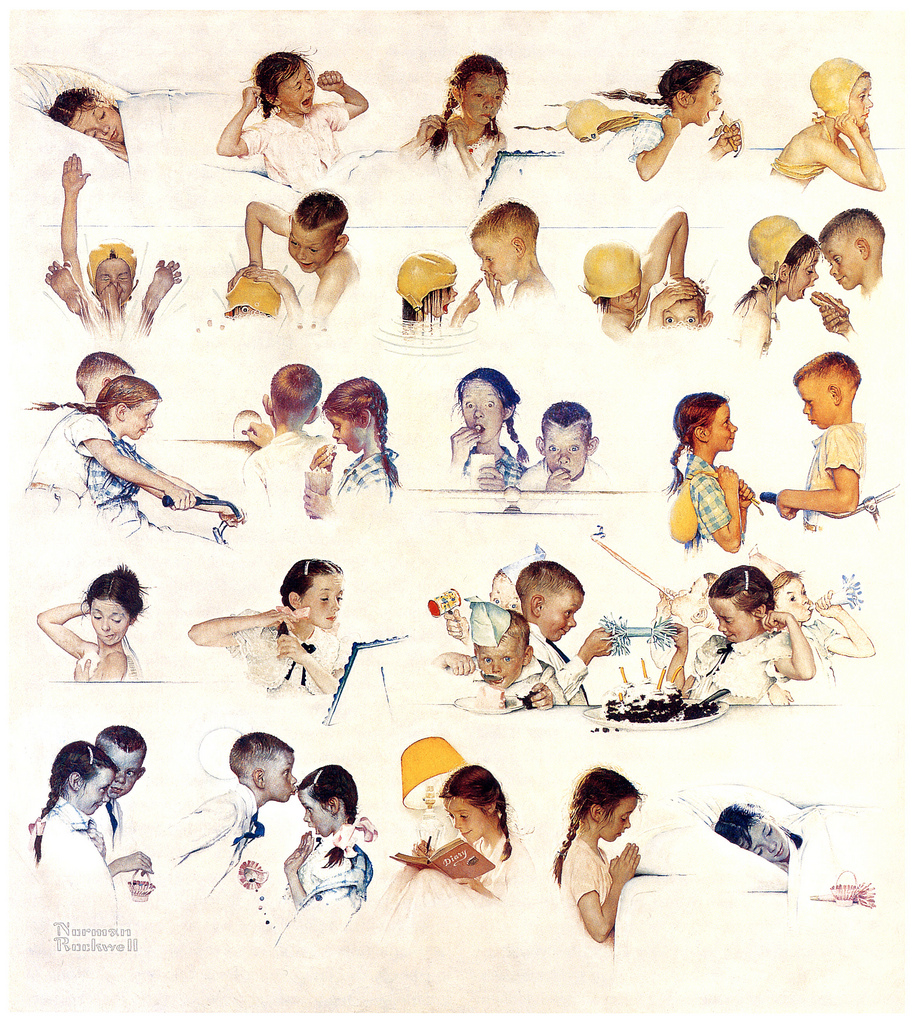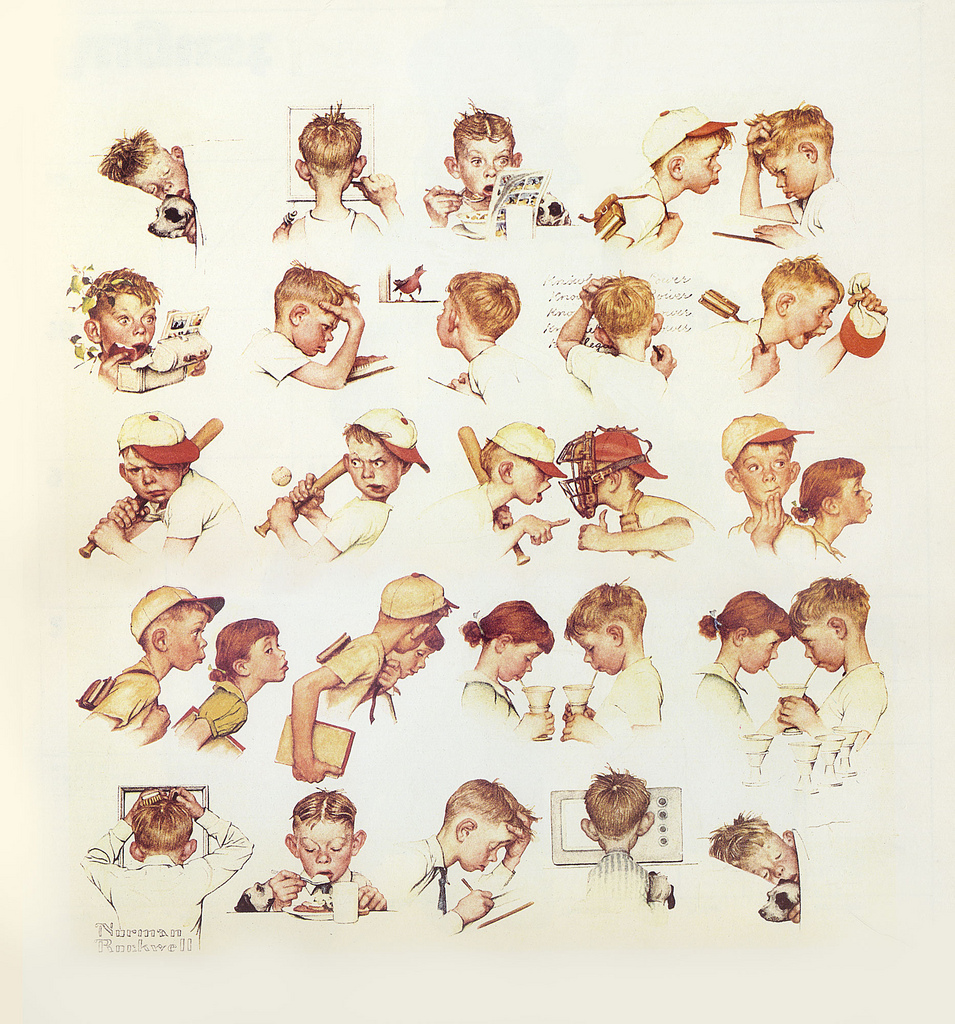Inspiration: Norman Rockwell and You
Overview:
This lesson will address Norman Rockwell’s points of inspiration including daily life in America and American culture. Students will then begin a long-term illustration project including a schematic layout, first draft and final piece. Each student will consider Rockwell’s quote, “I was showing the America I knew and observed to others that might not have noticed.”
Five 30 minute class periods: Class 1 Presentation; 2-4 Conceptual design, drafting, and completion of illustration; 5 Class critique.
Enduring Understandings/ Essential Questions:
- Norman Rockwell was inspired by his own experiences and life around him. Generally, he was influenced by what he experienced on his vacations, nature, his neighbors and friends. He was inspired by the American culture in general, including holidays, and celebrations. Norman Rockwell was also inspired by specific groups, such as the Boy Scouts of America although he, himself, was not a member of the group.
- What inspired Norman Rockwell?
- What do you find inspirational?
- How might you be “inspired” to create an illustration representational of what you know and observe in your everyday life?
- Grade
- 2-4
- Theme
- Four Freedoms, Artistic Process
- Length
- Five 30 minute class periods.
- Discipline
- Art
- Vocabulary
- Boy Scouts of America; Critique; Culture; Cool Colors; Environment; Idioms; Inspire/Inspiration; Thumbnail Sketches; Representational Art; Symbol; Visual Narrative; Warm Colors
Objectives:
- Students will consider everyday American life and cultural events as a means of inspiration (both for Rockwell and in preparation for their own piece of artwork).
- Students will look at and analyze the following three pieces of artwork by Norman Rockwell from a cultural point of view: Day in the Life of a Little Girl, Day in the Life of a Little Boys and The Gossips.
- Students will complete the worksheet Think Sheet: My America Sequence 2-4 in order to create a schematic layout design for their own personal sequential illustration.
- Students will include color in at least one area that demonstrated knowledge of color theory as a visual reference to mood or emotion.
- Students will participate in a group critique in an appropriate manner.
Background:
Norman Rockwell was surrounded by a supportive (and inspirational) community of friends and fellow artists when he lived in Arlington, Vermont from 1939 to 1953. During this time he created The Gossips which became the most popular Saturday Evening Post cover in 33 years. Norman Rockwell used his neighbors as models, but did not want to insult them so he put himself and his wife into the cover design to avoid any suspicions his friends might have. The very first version began with just two gossips, then ten and finally developed into the multiple frames you see today.
Materials:
Multimedia Resources
The Gossips
Day in the Life of a Little Girl
Day in the Life of a Little Boy
American Chronicles: The Art of Norman Rockwell
Norman Rockwell Museum
Classroom Supplies:
- American Chronicles: The Art of Norman Rockwell by Linds Szekely Pero
- Large easel with paper pad and pen or chalk board/white board
- Worksheet: Think Sheet: My America Sequence 2-4
- Colored pencils, fine tipped pens
- Final Draft Paper
Additional Teaching Resources:
The Norman Rockwell Museum at Stockbridge by The Norman Rockwell
Museum
My Adventures as an Illustrator by Norman Rockwell
Norman Rockwell: Behind the Camera by Ron Schick
Norman Rockwell’s America,by Christopher Finch
Norman Rockwell’s Four Freedoms: Images that Inspire a Nation by Stuart Murray, and James McCabe
Norman Rockwell’s Counting Book by Gloria Tabor
Norman Rockwell :Storyteller with a Brush by Beverly Sherman
A Rockwell Portrait: An Intimate Biography by Donald Walton
Activities:
Class One
The students will be seated in a comfortable way so they are able to see one another and can participate in a class conversation led by the instructor. The teacher will have a marker/chalk/crayon and a board or easel to write on.
- Ask the students to listen attentively to one another as they share personal responses throughout the lesson. Ask a student to define the words inspire and inspiration. A definition will be written on the board to refer to later on in the lesson.
- An index card and a pencil will be given to each student. The students will be asked to respond to one or both of the following questions (on the index card), “What inspires you?” or “Who inspires you?” Give the students a couple of minutes to write down their ideas. Ask one or two students to share one of their ideas with the class..
- Show an image of The Gossips by Norman Rockwell and ask the students if anyone has seen this illustration before. The children will be asked to point out only what they see, not what they perceive at first. The class will collectively take a visual inventory. As each student contributes, restate their observation. You might be able to elaborate on what they have said to add more visual detail or you might ask them for clarification. You might encourage them to look more closely and carefully. By doing this, the students will analyze the work and find clues and symbols to help read the visual image, revealing American culture.
- Read an excerpt from American Chronicles: The Art of Norman Rockwell by Linda Szekely Pero explaining the what inspired Norman Rockwell and how his family and surroundings helped grant him creative ideas for his artwork (page 99-100.) Upon completion, ask the children to recall some of Rockwell’s points of inspiration and record the list on a large paper easel or board. Student participation is critical to this discussion.
- Show two other images by Rockwell and allow for time for the children to look at closely: Day in the Life of a Little Girl, Day in the Life of a Little Boy. Ask the students to explain the sequence of the images looking closely and using the clues that Rockwell provides.
Class 2
- Briefly review the list created last class about what inspired Norman Rockwell. Distribute a copy of the worksheet Think Sheet- My America Sequence 2-4 to all of the students. Read over the worksheet and explain that this is meant to help them brainstorm their ideas and create a plan for their illustration ideas. Walk around the room for to check informally for understanding and to help students by conferencing individually. Check that their storyline is clear. You may ask the students to share their idea with the group, if time allows.
Classes 3-5
- During class 3, the students will pause on their individual projects to talk about color theory relating warm colors and cool colors to moods and emotions. Each student will be asked to apply this to their illustration in at least one area (for example: If the student has chosen the summertime as the setting, then using hot colors would emphasize the heat of the sun or if the student is depicting themselves as being sad, using cool colors would emphasize sadness.)
- Two more classes will be allotted for the completion of the student narratives. When most of the students have finished the project, ask the group to come together to conclude the project by presenting their illustrations to one another during a group critique to gain further feedback from their peers about their personal piece. Ask the students to present their project and explain their thoughts, particularly pointing out the one area where color has been intentionally used to emphasize a mood. Ask each student to point out what clues they have used so another may understand the setting and action. Once the artist has spoken, allow a couple of comments from classmates to be given. The comments must be given in a respectful manner, demonstrate critical thoughts and be relevant to the project. For example, a student might say, “I like the way you tinted the snowman blue to emphasize it is cold outside.”
Assessment:
Students will be evaluated on their participation in the class discussion and in the group critique (informal checks of understanding through questions.)
- Students will be evaluated on the completion of the worksheet, including thumbnail sketches for the final, individual project regarding their own interpretation of American life as they know it. Students will be expected to revise their work before completion of their final illustration.
Standards
This curriculum meets the standards listed below. Look for more details on these standards please visit: ELA and Math Standards, Social Studies Standards, Visual Arts Standards.
- VA:Cn.10.1.2
- Create works of art about events in home, school, or community life.
- VA:Cn.10.1.3
- Develop a work of art based on observations of surroundings.
- VA:Cn.10.1.4
- Create works of art that reflect community cultural traditions.
- VA:Cn11.1.2
- Compare and contrast cultural uses of artwork from different times and places.
- VA:Cn11.1.3
- Recognize that responses to art change depending on knowledge of the time and place in which it was made.
- VA:Cn11.1.4
- Through observation, infer information about time, place and culture in which a work of art was created.
- VA:Cr1.1.2
- Brainstorm collaboratively multiple approaches to an art or design problem.
- VA:Cr1.1.3
- Elaborate on an imaginative idea.
- VA:Cr1.1.4
- Brainstorm multiple approaches to a creative art or design problem.
- VA:Cr1.2.2
- Make art or design with various materials and tools to explore personal interests, questions, and curiosity.
- VA:Cr1.2.3
- Apply knowledge of available resources, tools, and techniques to investigate personal ideas through the art-making process.
- VA:Cr2.1.4
- Explore and invent art-making techniques and approaches.
- VA:Cr2.2.2
- Demonstrate safe procedures for using and cleaning art tools, equipment, and studio space.
- VA:Cr2.2.3
- Demonstrate an understanding of the safe and proficient use of materials, tools, and equipment for a variety of artistic processes.
- VA:Cr2.2.4
- When making works of art, utilize and care for materials, tools, and equipment in a manner that prevents danger to oneself and others.
- VA:Cr3.1.2
- Discuss and reflect with peers about choices made in creating art.
- VA:Cr3.1.3
- Elaborate visual information by adding details in an artwork to enhance emerging meaning.
- VA:Cr3.1.4
- Revise artwork in progress on the basis of insights gained through peer discussion.
- VA:Re7.2.2
- Categorize images based on expressive properties.
- VA:Re7.2.3
- Determine messages communicated by an image.
- VA:Re7.2.4
- Analyze components in visual imagery that convey messages.
- VA:Re8.1.2
- Interpret art by identifying the mood suggested by a work of art and describing relevant subject matter and characteristics of form.
- VA:Re8.1.3
- Interpret art by analyzing use of media to create subject matter, characteristics of form, and mood.
- VA:Re8.1.4
- Interpret art by referring to contextual information and analyzing relevant subject matter, characteristics of form, and use of media.
- VA:Re9.1.2
- Use learned art vocabulary to express preferences avout artwork.
- VA:Re9.1.3
- Evaluate an artwork based on given criteria.
- VA:Re9.1.4
- Apply one set of criteria to evaluate more than one work of art.


